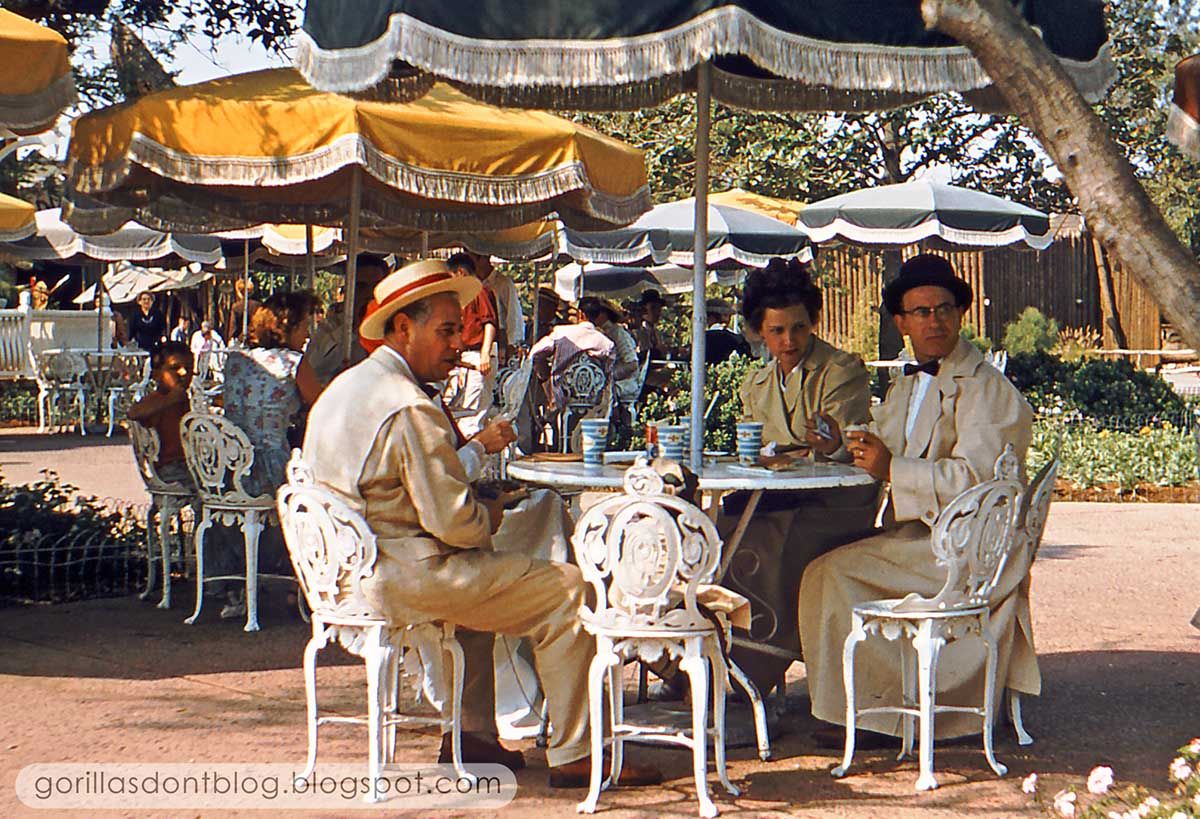Random Randomness
Happy 60th Birthday, Disneyland!
I don't have anything extra-special planned for this extra-special day, but I DO have a couple of nice random views, starting with this fun photo (circa 1956), taken over near the Plaza Pavilion, I believe. A group of guests are dressed in their finest 1910-era clothing. My guess is that they belonged to the "Horseless Carriage Club", a group that visited Disneyland in the early years, even driving their flivvers up Main Street.
The guy with the cigar looks like a character actor, he has panache! He and his friends appear to have spotted something that does not meet with their approval!
Next is this nice shot of the E.P. Ripley, in an undated slide that is almost certainly from the 1950's. I'm not sure exactly where our photographer would have been standing; it looks like the parking lot is beyond the berm, so the train might be in that area between Adventureland and Frontierland.




16 comments:
Major-
That's definitely the Plaza Pavilion where those fine folks are dining - dressed as if from the time Main Street is depicting. The cigar-smoking, straw hat-wearing, gent with panache, is perfectly blocking (presumably) another woman. Too bad.
Thanks, Major and Happy Birthday Disneyland-!
The random randomness is great.
Love the Horseless Carriage Club image. Whether it was called The Pavillion, Plaza Pavilion or Jolly Holiday Bakery Café, this location along with the French Market has always been a favorite of mine for dining alfresco.
The E.P. Ripley image with its open sky, sparse vegetation and fresh looking track ballast is nice. It definitely looks like it's coming in from the outskirts of Adventureland, towards the old Frontierland Station. Thanks, Major.
It's hard to believe it's been sixty years. Happy 60th Birthday, Disneyland!
Very nice "rods down" image of the E.P. Ripley!
"Happy Birthday" to Disneyland, and a "Very Merry Unbirthday" to the rest of you!
Ken, it IS hard to believe that Disneyland is 60, and at the same time, it's hard to believe that it's ONLY 60. It's become such an icon of American culture that it's hard for those of us who came along later to imagine a time without a Disneyland. In a way, it always HAS been there in the hearts of the young and the young at heart - it just took a Walt Disney to make it something real.
Here's to another 60 years of smiles, laughter, and wonder!
I tried to dress with panache once. About halfway through I realized I was dressing with ganache, which is apparently something TOTALLY DIFFERENT and REALLY MESSY. Should have worked harder on that damn alphabet song.
These are absolutely charming pictures, and sum up two of the most important things Walt wanted when he built his park: trains and old-timeyness. So, they're perfect for the anniversary!
@ Melissa-
Messy, perhaps - but wasn't it delicious-??!!
Steve DeGaetano, I searched and found a previous comment you made using the term "rods down" meaning the rods are at the bottom of the stroke, sort of equivalent to a ship with unfurled sails. I never heard that one before. I know a bit about trains, but it just goes to show that no matter how much we think we know, we learn something new every day. Thanks!
Chuck, As a kid, I always thought of Disneyland as something that was always there and always would be. Later on I would learn just how temporary certain components of Disneyland would be. That was a shock to my Disneyland lovin' mind set. Still at its core it's a wonderful and magical place to visit. It must be doing something right to keep us coming back for sixty years.
Nanook, I can’t decide if these folks fall into the “Dapper Day” category, or if they are “cosplayers”!
K. Martinez, the weirdest thing is that the 50th seemed like it was two years ago. How can it be 10 years since then?
Steve DeGaetano, I thought you might like that one!
Chuck, I think the Disney Company needs to hire you to write some of their PR copy! Your comment reminds me a bit of some of the better work from Marty Sklar.
Melissa, you can still dress with ganache and have panache! They are not mutually exclusive.
Nanook, I imagine following the trail of chocolate goo throughout the park.
K. Martinez, I’m not sure I understand the significance of the rods being in the “down” position. Why is that the equivalent of unfurled sails?
Major, I assumed it meant at its optimal appearance or presentation. Maybe I took it out of context. Here's the thread from C.K. Holliday Plans that contains Steve's comment.
http://ckhollidayplans.com/blog/slow-days/#comments
Major, when the siderods are in the "down" position, they represent the maximum force being exerted by a particular piston on a drive rod to move the drive wheels forward, which in concept corresponds to a sailing ship in full sail. In my opinion, it also just looks better, like a sailing ship in full sail, but that may just be conditioning from years of looking at idealized pictures of locomotives with the siderods down. The convention is so ingrained in the community that even model train catalogs feature photos of the models with the siderods down (a fact I'd never noticed until today).
For reference, here's an animation of a steam locomotive's running gear in operation: https://myweb.rollins.edu/jsiry/walsch2.gif. Note that the running gear on the opposite side of the locomotive will be a mirror image of what you see here, with the wheels traveling counterclockwise instead of clockwise. Both sets of siderods, drivers and cylinders are synchronized to run at the same speed but are "quartered" at 90º from each other, that is, they are timed to reach the bottom of the stroke at different times to smooth the engine's motion, much like the way a car's pistons are synchronized to fire in sequence instead of all at once. Most railroads quartered their locomotives with the right-side crankpins (the points where the driver and siderods were attatched to the wheels) leading the left, although there were notable exceptions such as the Pennsy. I don't know which side the DLRR leads with. Steve?
Chuck, great follow up! Your explanations are detailed and thorough. I have stacks of old train catalogs and I never thought about the "rods down" position until today. I'm definitely going to dig some of those catalogs out and take a look-see. Thanks!
Correction to what I wrote above...my first sentence describes a steam engine with single-action steam cylinders, but most steam locomotives have double-acting steam cylinders. On a double-acting steam cylinder, the cylinder and valves are designed to allow high-pressure steam to act on both faces of the piston, which would mean that equal force is being applied at the same relative position on both the downstroke as well as the upstroke (an animation of a double-acting cylinder can be found here: http://www.animatedengines.com/locomotive.html).
Additionally, while quartering is helpful in smoothing a locomotive's movement, another reason for quartering is to ensure the engine will start no matter the starting position of the drive rods.
K. Martinez, this is the first I have ever heard of a preference for “rods down”!
Chuck, that animated gif was very helpful. I’m not sure that I think it looks a lot better though; my cave man brain likes the way the train looks regardless of the position of the rods! How do you know so much about trains? Just from reading? Reading is for nerds! ;-)
K. Martinez, I would be curious to know if they really are pictured with the rods down.
Chuck, interesting; I know that steam engines are primitive by today’s standards, and yet I am still impressed that somebody figured the darn things out! And that they not only worked, but that they were extremely powerful. I assume that the single-action cylinder was earlier, and the double-acting cylinder was an advancement? Or did they both exist at the same time for many years?
I learned a lot of it by osmosis - my dad is a huge railfan (although not quite to the "foamer" stage Steve DeGaetano mentions in the link K. Martinez lists in the thread above). That said, I continue to learn (and sometimes re-learn) by old-fashioned reading ever since I shorted out my neural jack two years ago in a hot tub in Vegas.
You're correct - the single-acting cylinder is a simpler, earlier design, but the double-acting cylinder is much more efficient. And as I continue to re-learn the history of steam engine development this evening, I'm now convinced that only the very earliest steam locomotives might have used single-acting cylinders...if any did at all.
I've never heard of a single acting steam cylinder. But you're right--the double acting cylinders, quartered 90 degrees, means that one piston or the other will always get some power to start. Now, for comparison, just think about trying to pedal a bike from standstill with the pedals perfectly up and down!
Photographers like to get shots of the engine with the rods down, just for aesthetic reasons--yes, just like unfurled sails, billowing in the wind. Obviously, it takes some luck!
I think every hobby has standards like "rods down." When people take pictures of bicycles they've built, the convention is to take a picture from the right side, so you can see the gears and chain.
Post a Comment